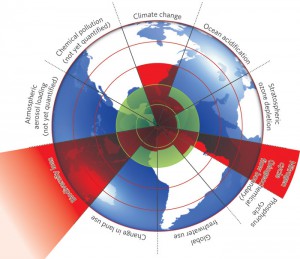At the first Ecocity Focus Lab held in Vancouver in November 2016, participants worked on confirming headline indicators for the International Ecocity Standards. A report was produced that will lay the foundation for indicators and benchmarks by which to measure and assess the 18 system conditions of an ecocity. Specifically, this report identifies the lead indicator recommended to measure each system condition. It is understood that several indicators may be needed to accurately assess each standard, but the purpose of identifying a leading headline indicator is to facilitate the effective use of scarce resources when cities begin to measure what matters when attempting to achieve the Ecocity Level 1 system conditions across all 18 standards.
In preparation for the upcoming Ecocity World Summit 2017 conference in Melbourne, July 12-14, the Ecocity Focus Lab report identifying headline indicators for the International Ecocity Standards is being publicly released for review and discussion. This document complements the recently updated International Ecocity Standards brochure.
Participants at the upcoming Ecocity World Summit will have an opportunity to discuss the standards and the headline indicators at the Ecocity Builders workshop to be held Thursday, July 13th from 11:00 a.m. to 12:30 p.m. in Session 3A ”Cities Becoming Ecocities: Standards, Tools and Methods for Cities, Citizens and Urban Service Providers.”
If you are not attending the conference, your feedback is also welcome. Please drop us a line by responding to this article on the Ecocities Emerging blog.
Richard Register is on the road again, leaving this week for Bhutan where he will meet with government officials about building ecocities in Panbang, a province of Zhemgang.
Bhutan is a small Buddhist county nestled in the Eastern crags of the Himalayas, commonly overshadowed in the news by its neighbors Tibet, Burma, China and India. Bhutan is most commonly known for its policy of Gross National Happiness (GHN), a metric introduced by King Jigme Khesar Namgyel Wangchuckn and used to measure the well-being of its citizens and guide the development of government policy. The four pillars of GNH are the promotion of sustainable development, preservation and promotion of cultural values, conservation of the natural environment, and establishment of good governance.
The GNH measures reflect Bhutan’s Buddhist foundations which emphasize the need for spiritual and moral development to coincide with material development. Bhutan is cautious about modernization, and justly so. Most countries have embraced the luxuries of modernity while degrading precious traditional values and our connection to nature.
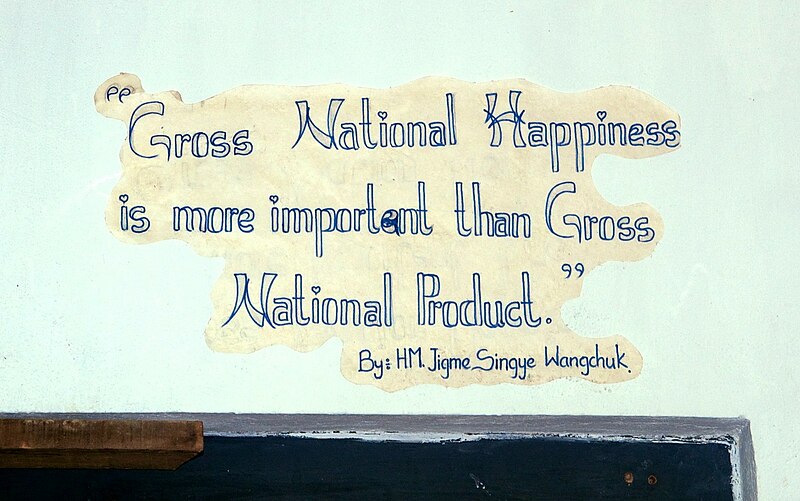
Slogan on a wall in Thimphu’s School of Traditional Arts. Court. of Wikimedia Commons.
King Wangchuck broke with his father’s legacy and has opened Bhutan to modern changes little by little (Television appeared for the first time in 1999), hoping to adopt the benefits of new technology while avoiding the evils. The results are mixed – crime, materialism and dissatisfaction are rising, but not to the rates of most other countries. Some educated Bhutanese returning from educations in the West seek to lead the country in a unique blend of Buddhist values and Western practices.
For example, for every tree cut down they plant three new ones and claim to be the only country with proven negative CO2 production, that is, they absorb more CO2 out of the atmosphere than they put into it. Notably, English has been adopted as the universal language in Bhutan and is taught in the all free school system there (financed largely by sale of electricity from hydropower to India), a testament to the seriousness of their careful opening to modern ideas and ways.
Bhutan faces the enormous challenge of engaging reasonable change without being overwhelmed by the two gigantic countries on either side: China and India, India being their closest development partner to date. China crushed Buddhist Tibet and India ousted the Buddhist government of Sikkim, leaving Bhutan as the last country in the region with a King and traditional Tantric Buddhist religion at its core. At the same time, the King instituted a parliamentary system and has granted increasing legislative and administrative powers to a growing to date ever more democratic government.
The concept of the ecocity blends well with the philosophy of Bhutan. An ecocity is an opportunity to balance modern technology with these traditional values, blending simplicity and convergance to nature with infrastructure to support modern conveniences such as sanitation and electricity. Bhutan’s proposed ecocity will be situated near the south edge kingdom, north of the Gangiatic plane, and south of the foothills of the Himalayas. The idea is to build a leading city for “education, sport and eco-tourism” with an eye to bringing their GNH (Gross National Happiness) theme together with the leading ecocity project in the world.
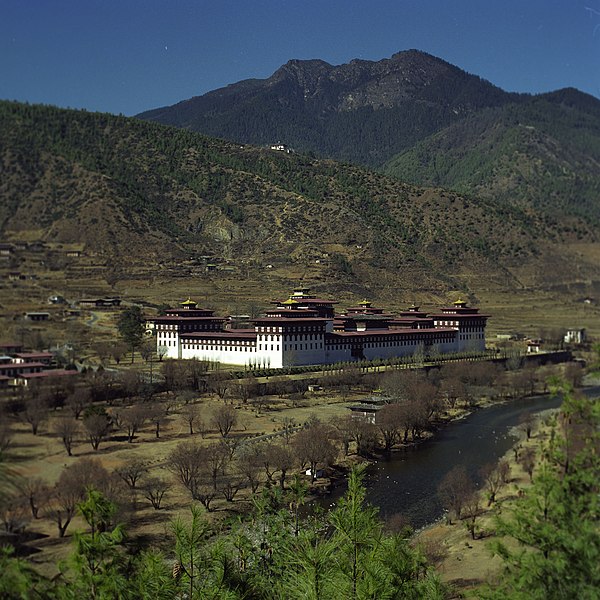
Tashichho Dzong, a Buddhist monastery and seat of the Druk Desi, the head of Bhutan’s civil government. Court. Wikimedia Commons.
Richard’s vision is to take seriously the notion that happiness is a higher goal than maximum materialist consumption. It seems unthinkable that the general happiness and well-being of a people is not the highest priority indicator of their wealth. Yet Bhutan is the only country to explicitly say so. For the rest of us, the generation of paper and electronic numbers continues to be the applauded standard of well-being. We are left with other numbers to suggest the failings of our own gross national happiness: rising rates of disease, hospitalization, divorce, drug use and more.
Says Richard, “If we can design and build the sustainable city for a happy future – it would be such a large chunk of the solution, who could ask for anything more?”
Just in time for Rio+20, we’re happy to announce that Ecocity Builders has launched the EcoCitizens World Map project in conjunction with nonprofit tech company Ushahidi.
This map, based on the Ecocity Framework, offers a place and a pathway for people everywhere to add their voices and be counted as contributing members of the new green and equitable economy.
From community garden, clean energy, or ecoliteracy projects to waterway restorations, green businesses, or new bicycle pathways, the EcoCitizen World Map Project is an invitation to ecocitizens around the world to share anything that is improving the health of the complete urban ecosystem somewhere in their neighborhoods and communities.
The Santa Teresa neighborhood in Rio de Janeiro has taken the lead in mapping their diverse community. We are now inviting all parties interested in increasing visibility and outreach for their Rio+20 related work around the world to join as part of the Rio+20 process.
by Jennie Moore, Director of Sustainable Development, British Columbia Institute of Technology-School of Construction and the Environment
Update on Vancouver’s Second IEFS Workshop
The City of Vancouver is an early partner city to the development of the International Ecocity Framework and Standards (IEFS). On February 9th, 2012, BCIT hosted a workshop led by Ecocity Builders to assess progress to date in the IEFS development and explore next steps. Workshop participants included representatives from the City of Vancouver and many other local government and provincial government agencies, the construction industry, and non-government organizations.
The workshop built on the outcomes of a previous workshop held in Vancouver in 2010. At that time, the original concept of the IEFS was introduced and participants worked on establishing the fifteen conditions that now comprise the standards. Participants also identified the need to develop a guiding framework.
At this year’s workshop, participants reviewed the progress made to date, including the first attempt by City of Vancouver staff, in 2011, to assess their City’s performance using the IEFS. Important data gaps in the areas of soil fertility and food growing capacity were identified; however, City staff reported that the IEFS can be used to assess the City’s performance. Moving forward from that review, the workshop participants re-iterated the importance of metrics to both guide and inform performance.
Workshop participants broke into five table groups to further explore:
- Ecocity mapping
- Bio-geophysical conditions (City within its bioregion)
- Bio-geophysical conditions (City and the environment)
- Socio-cultural conditions and Eco-citizenship
- Assessment metrics
The IEFS workshop proceedings are available here.
British Columbia Institute of Technology-School of Construction and the Environment
is Lead Sponsor of the International Ecocity Framework and Standards Initiative
by Richard Register, President, Ecocity Builders
 It’s closer than you think to the UN Rio + 20 Conference! (June 2012) We in Ecocity Builders see this as a time of immense importance. A time to rekindle and uplift spirits of the possible, desirable and creatable. That of course depends on having the right ideas and the energy to pursue them. And we think we are on board in exactly that way. There is an enormous opportunity there if we can grasp it and inspire others.
It’s closer than you think to the UN Rio + 20 Conference! (June 2012) We in Ecocity Builders see this as a time of immense importance. A time to rekindle and uplift spirits of the possible, desirable and creatable. That of course depends on having the right ideas and the energy to pursue them. And we think we are on board in exactly that way. There is an enormous opportunity there if we can grasp it and inspire others.
We bring two especially strong solutions:
First – and this is very particular to Rio de Janeiro – the world is growing slums faster than cities, and that’s saying something frightening, but also something in a strange way hopeful in that at least some of the favelas hold lessons for the sustainable future while we in the ecocity movement hold complementary lessons of our own.
If we can help answer the problem of slums and if it turns out to answer a range of other crucial urban issues – and it does – then we are accomplishing something truly profound. Bringing the two together in Rio – favela solutions and our own solutions from the ecocity movement – could be a move to cross over the threshold of resistance and glumness we see pervading most attitudes toward the United Nations recently, especially disturbingly exhibited in the way negotiatios for climate solutions have been stonewalled. But the solutions at the confluence of the Rio/Ecocity confluence could be a breakthrough.
Second,
the ecocity movement has been refining the notion of what an ecocity actually is and how it could contribute essential insights, principles and guidelines to urge, shape and assess city policies and actual physical form and function in a transformation toward a sustainable future. The new tool on the block is the International Ecocity Framework and Standards (IEFS), guided by Ecocity Builders and a committee of international experts from the US, Canada, Australia, Bangladesh, China, Brazil and expanding in other places. Notably, its development involves the leadership of ecocity movement veterans in Vancouver, Canada centered around the British Columbia Institute of Technology and the University of British Columbia.
by Sven Eberlein
The following is an excerpt from a series of workshops and meetings discussing the IEFS with a range of stakeholders and expert advisers in Vancouver, Canada, from February 9-14.
The original series was published on Daily Kos and can be found in its full length at the following links:
Carless in Vancouver, Part 1: Boots on the Ground
Carless in Vancouver, Part 2: Going for the high-hanging fruit
Carless in Vancouver, Part 3: Follow the Flow
Saturday, February 12th
The IEFS Core Advisory Committee meeting took place at Core Adviser Jennie Moore and her partner Jonn’s place in West Vancouver. While not everyone on the committee had been able to make it to Vancouver, we had a nice core group of Jennie, Jonn, Kirstin Miller, Richard Register, and special guest Sebastian Moffatt, visionary building scientist, environmental planner, and co-author of Eco2 cities: ecological cities as economic cities, who was joining us for the day to share some of his methods of measuring material flow in an organism as complex as a city.
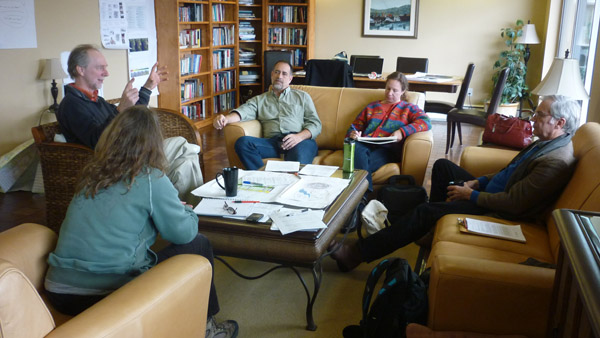
by Sven Eberlein
The following is an excerpt from a series of workshops discussing the IEFS with a range of stakeholders and expert advisers in Vancouver, Canada, from February 9-14.
The original series was published on Daily Kos and can be found in its full length at the following links:
Carless in Vancouver, Part 1: Boots on the Ground
Carless in Vancouver, Part 2: Going for the high-hanging fruit
Carless in Vancouver, Part 3: Follow the Flow
Friday, February 10th
The second IEFS-related workshop took place at the BCIT’s School of Construction and the Environment‘s Burnaby campus in the Eastern part of Vancouver. The theme of the session is to make the BCIT campus into an Ecocity School, a model that could be followed by others.
After a “Lunch and Learn” with Ecocity Builders’ Richard Register and Kirstin Miller, Jennie Moore, Director of Sustainable Development and Environmental Stewardship at BCIT and IEFS Core Adviser, reports on the progress made since a campus ecocity design charrette was done a couple of years ago.
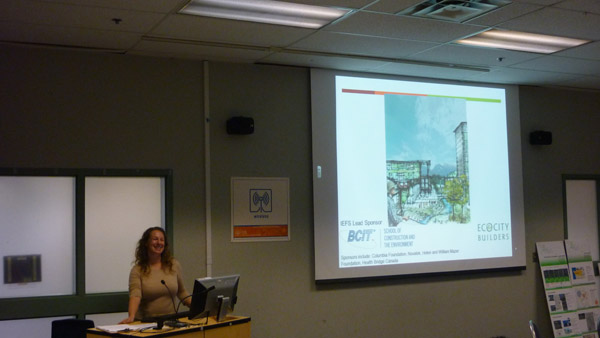
by Sven Eberlein
The following is an excerpt from a series of workshops discussing the IEFS with a range of stakeholders and expert advisers in Vancouver, Canada, from February 9-14.
The original series was published on Daily Kos and can be found in its full length at the following links:
Carless in Vancouver, Part 1: Boots on the Ground
Carless in Vancouver, Part 2: Going for the high-hanging fruit
Carless in Vancouver, Part 3: Follow the Flow
Thursday, February 9th
The first IEFS workshop took place at the BCIT’s School of Construction and the Environment‘s Downtown Vancouver campus.
It was quite a conglomeration of luminaries that had gathered: Representatives from the City of Vancouver, Metro Van, industry, and real estate, as well as LCA experts and people like Gordon Price, Vanessa Timmer, Bill Rees, Sebastian Moffatt, and Jennie Moore.
Ecocity Builders Executive Director Kirstin Miller gave a brief update on the current blueprint of the IEFS, and the 15 conditions that would need to be addressed in order for a city to achieve basic “ecocity” status.
Next, we split up into 5 groups. Table 1 had the entire City of Vancouver crew ecocity-mapping their metro area, moving from a sprawling urban agglomeration to an eco-tropolis. They defined major centers, small town centers and neighborhood centers that could over time attract more density, be connected via public transit, bike and greenways, and restore agricultural land, habitat corridors, urban streams and parks between and around them.
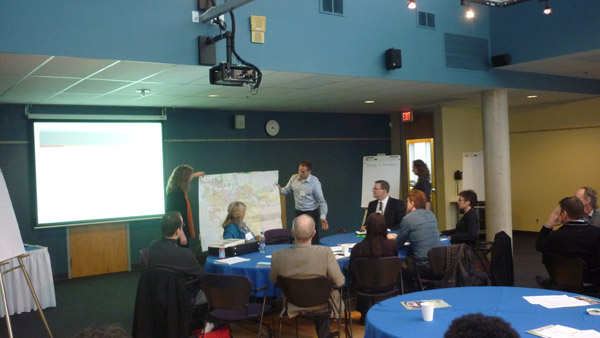
Excerpted from the October 2011 editorial of Ecocities Emerging, the newsletter of Ecocity Builders and the International Ecocity Conference Series
“Why are we here?” It’s a question often posed philosophically. Posed practically, the answer is pretty straightforward – we’re here because our planet supports conditions for life, including human life. Alarmingly, humans are now impacting living systems to a point where our life-sustaining conditions are being undermined. The deeper and more urgent question at this point is: “How do we stop doing this — and what can we do to support and sustain both people and planet?”
We know that the answer to this question must be framed within the limits of what the planet can provide while maintaining stable life supporting conditions. Scientists at the Stockholm Resilience Centre have outlined nine planetary boundaries as comprising a “safe operating space” for humanity. Drawing upon current scientific understanding, quantifications have been proposed for seven of them:
1. climate change;
2. ocean acidification;
3. stratospheric ozone;
4. biogeochemical nitrogen (N) cycle and phosphorus (P) cycle;
5. global freshwater use;
6. land system change; and
7. the rate at which biological diversity is lost.
The two additional planetary boundaries for which thresholds have not been yet established are:
8. chemical pollution and
9. atmospheric aerosol loading.
We have already transgressed 3 planetary boundaries: climate change, rate of biodiversity loss, and changes to the global nitrogen cycle. We are in a critical predicament. The question remains unanswered. Can humanity – cities and citizens – exist, even thrive, within the boundaries? We believe that we can. Cities, we believe, can save the earth.
And cities already have helped save the earth once before. When it was discovered in the mid 1980s that there was a ozone hole in the atmosphere (conditions causing the stratospheric ozone layer to become very thin) creating dangerous and unhealthy biological consequences, cities in the United States came together to ban the CFCs that were causing the problem as outlined in the Montreal Protocol, even though then President Bush and his administration were refusing to include language in the Clean Air Act to put the Montreal Protocol into effect. But cities took action anyway. Their efforts got the attention of the United Nations and the world and led to the formation of ICLEI, Local Governments for Sustainability, an organization that went on to further assist cities in taking local action on global issues through the adoption of local Agenda 21 plans, Climate Action Plans and other initiatives. More on ICLEI’s story in next month’s newsletter.
A planetary boundary that was threatened (stratospheric ozone) was restored. This is a significant accomplishment that is not talked about very often, but it should be. The Montreal Protocol embodies the principle agreed at the United Nations Conference on Environment and Development in 1992 that “countries have a common but differentiated responsibility to protect and manage the global commons.”
We can live within our planetary common boundaries, but only when we know what this kind of living looks like and how it is applied. Once we know that, we can then finally accurately define “the green economy” (one of the major themes of the upcoming UN Earth Summit), and know how to best invest in humanity’s healthy future with fairness and equity. Ecocity Builders and our international associates and advisors are currently sharing work to date on defining conditions and an approach for living and thriving within the planet’s safe operating boundaries, now and into the long-term future. The International Ecocity Framework and Standards initiative is bringing together cities, citizens, academics, scientists, business, government and NGOs around a shared vision of sustainable development – a way to successfully live within this safe operating space. (The IEFS’s 15 basic conditions for sustainable development are listed here.)
Cities can save the world.
As we build, so shall we live.
Kirstin Miller
Executive Director, Ecocity Builders
by Richard Register

Richard Register, President, Ecocity Builders and founder of the International Ecocity Conference Series. Photo by Susan Felter.
At the Ecocity 9 international conference in Montreal, Kirstin Miller organized a panel of short presentations by members of our international team drafting the IEFS. She described the history of the project and progress that has brought us to a point where we now have a solid set of core authors and supporting advisors, including Bill McKibben, author and major leader in climate change education and policy action; Mathis Wackernagle, co-author of the ecological foot print concept and President of the Global Footprint Network; Warren Karlenzig, President, Common Current, a global urban sustainability policy consulting company; Rusong Wang of the Chinese Academy of Sciences, Member of the Chinese People’s Congress and Ecocity 5 Convener; Peter Gleick, President of the Pacific Institute, a water policy think tank; Ian Douglas President of the International Council on Ecopolis Development and President of the Society of Human Ecology, and other expert advisors.
©2022 Ecocity Builders


